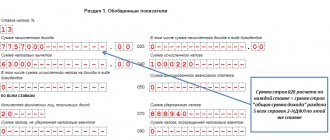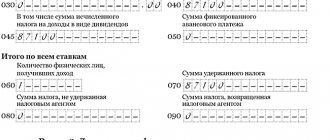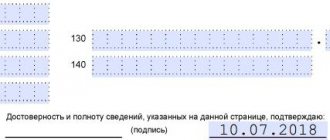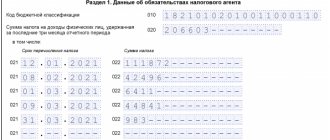Purpose of form 6-NDFL
To improve control over the timely receipt of income tax into the budget, form 6-NDFL was developed.
This form is submitted by entrepreneurs and organizations that have employees or are tax agents for other individuals. The task of those submitting the report is to provide reliable information on all calculated income, deductions, and tax payments. The task of the inspectors is to verify that the tax is calculated correctly and paid on time.
Data from tax registers must be used to complete the report. This is a requirement of Art. 80 Tax Code of the Russian Federation. The absence of such a register will be considered a violation and will be fined by controllers. This register can be developed independently by approving its form in the accounting policy. Every month you need to keep records of salary accruals and other income, tax calculation and withholding, and the dates of tax transfer to the budget.
You can see how to correctly compile such a register in our article “Sample of filling out a tax register for 6-NDFL” .
The data in section 1 of the calculation is indicated on an accrual basis from the beginning of the year, in section 2 - only for the last 3 months. Unlike the 2-NDFL reporting form, in this calculation all information is summarized without detailing by name, but broken down by date of transactions.
How to fill out the remaining lines of the report is discussed step by step in ConsultantPlus. See the authoritative opinion of K+ experts in the Ready-made solution by receiving free trial access to the legal reference system.
Which inspectorate will need to submit 6-NDFL calculations?
Quarterly calculations and reporting for each individual based on the results of the tax period will need to be submitted to the Federal Tax Service at the place of registration of the tax agent. At the same time, the Tax Code of the Russian Federation clarifies:
- Russian organizations with separate divisions will be required to submit reporting documents to the inspectorate at the location of the separate divisions;
- the largest taxpayers will report to the inspectorate at the place of registration or to the inspectorate at the place of registration for the corresponding separate division (separately for each);
- individual entrepreneurs who are registered at the place of their activity in connection with the use of UTII and (or) the patent system will submit reports regarding their employees to the inspectorate at the place of their registration in connection with the implementation of this activity.
General rules for the 1st section of the report
The first section is a summary table of personal income tax data for the period of provision - the tax base and indicators calculated by the agent.
As we can see, there are two peculiar parts of the report. The top one is intended for income and tax calculated at different rates, the bottom one is for summing up information on all rates and indicating details (tax not withheld, returned).
The upper part must be completed for each tax rate applied by the agent. If, in addition to your regular wages, you paid winnings to an individual or you employ a non-resident whose income is taxed at a different rate than a resident, you will have to fill out several upper parts, one for each rate.
You will indicate the amount of income in field 020, the amount of deductions in field 030, and on page 040 you will need to indicate the amount of calculated tax. Separately, here you need to highlight the amount of tax calculated on dividends (on line 045) and indicate the advance payment (if you employ foreigners).
That's it, you've already filled out the top part of the section.
See also “How to fill out section 1 in the 6-NDFL report”.
How often are reports submitted?
Reporting on employee income taxes is submitted to the Federal Tax Service once a quarter. The deadline for submission is the last day of the month of the period following the reporting period. Information is presented on an accrual basis.
The reporting date for submitting the form is:
- date of receipt (date and time must be no later than twelve o'clock at night of the last reporting day) for submitting the form electronically;
- the date the Russian postal employee marks the attachment inventory as the date for submitting the form by mail;
- the date on your copy of the report, indicated by the inspectorate employee, when submitting the report in person to the Federal Tax Service.
Submission of the report in 2021 must be no later than:
- April 2;
- May 3;
- last working day of July;
- last working day of October.
Data to be reflected on line 040 6-NDFL
According to Art. 210 of the Tax Code of the Russian Federation, tax is calculated as a percentage of the tax base. In this case, the tax base is the total income of the taxpayer, reduced by the amount of deductions provided in accordance with the Tax Code of the Russian Federation.
The main interest tax rates for residents currently in effect are as follows:
- 13% - this may be salary, remuneration under civil partnership agreements, income from the sale of real estate or some other income;
- 35% - from the amount of savings on interest when receiving borrowed funds in terms of exceeding the established amounts.
Our section “Personal Tax Rate” will help you understand the general picture of personal income .
The calculation formula for calculating tax by a tax agent is simple:
(Individual's income - Deductions provided) × Tax rate for this type of income.
It is this amount that will appear in line 040 of the 6-NDFL calculation. That is, in relation to the report it will look like this:
(Page 020 – Page 030) × Page 010 / 100 .
If the calculated indicator does not coincide with the specified amount, this will not always be an error. The tax is calculated in full rubles. According to rounding rules, the tax amount is less than 50 kopecks. is discarded, and 50 kopecks. and more is rounded to the nearest ruble (rounding error). A discrepancy in any direction of up to 1 ruble is acceptable. for each individual. The published control ratios for checking Form 6-NDFL provide the following formula for calculating the permissible error:
Page 060 × 1 rub. × Number of lines 100 .
For example, if on line 060 “Number of people” you have 54 people indicated and during the reporting period income was paid 3 times (that is, line 100 “Date of actual receipt of income” is filled in three times), then the amount on line 040 for the 1st quarter may be 162 rub. differ from that calculated by the formula (54 × 1 × 3). The number of 100 lines will depend on the number of income dates in the reporting period.
IMPORTANT! But if the discrepancy exceeds the maximum error, then the tax authorities will consider that the amount of accrued personal income tax is underestimated or overestimated. This will result in a letter asking for clarification and an adjustment calculation.
How to do this, see our article “How to correctly fill out the clarification on form 6-NDFL?” .
Read more about control ratios for checking the form in our article “Control ratios for checking form 6-NDFL” .
Tax officials also compare the indicators of forms 2-NDFL and 6-NDFL. Find out what the amount of line 040 should be in ConsultantPlus by getting trial access to the system for free.
After filling out lines 010–050 for all tax rates applicable to your company, you can move on to the second part of the first section. There is line 070 here, which will summarize the withheld tax.
IMPORTANT! The amounts of calculated and withheld taxes (lines 040 and 070, respectively) may not coincide. This is possible if some income has already been accrued, the tax on it has been calculated, but the income has not yet been paid. For example, in a situation where salaries are accrued in one quarter and paid in the first month of the next quarter.
Let's compare the tax calculation dates and the withholding dates.
| Income | Tax calculation deadline | Tax withholding period |
| Salary | Last day of the month worked | On the day of payment in cash |
| Payments upon dismissal | Last working day | On the day of payment |
| Sick leave and vacation pay | On the day of payment | On the day of payment |
| Dividends | On the day of payment | On the day of payment |
| Travel expenses (not documented, “extra daily allowance”) | Last day of the month of approval of the advance report | On the day of salary payment for the month in which the advance report is approved |
| Income in kind | On the day of transfer of income | On the day of payment of the next income in cash |
Thus, we see that the dates for tax calculation and withholding do not coincide quite often. This means that inequality between lines 040 and 070 is common.
More information about the dates of receipt of income is described in the article “Date of actual receipt of income in form 6-NDFL”.
To learn how to reflect dividends in 6 personal income tax, read the article “How to correctly reflect dividends in form 6-personal income tax?”
Filling out the data section on dates, amounts of income received, personal income tax
The decoding of lines 6 of personal income tax of section 2 reflects:
- Revenue recognition dates.
- Deadlines for withholding and paying taxes.
- The total amounts of actually recognized income, tax to be withheld for all employees.
Decoding of lines 6 of personal income tax is entered in blocks as many times as the number of times payments were made to the organization’s employees.
Below is an explanation of the lines.
| Line number | Information |
| 100 | In 6 personal income tax, line 100, the date of actual receipt of income is reflected in accordance with Art. 223 Tax Code of the Russian Federation. The date of accrual of the advance payment and final payment of wages is the last day of the month of salary payment. The day of recognition of vacation income is the day of their payment. The date of recognition of benefits for sick leave is the day of payment of the calculation for the certificate of incapacity for work. The date of recognition of income in the form of an annual bonus is the last day of the month from which the date of the bonus order; the date of recognition of income when paying a monthly bonus is the last day of the month of the bonus. (letter from the Federal Tax Service No. BS-4-11/1139 dated January 24, 2017) |
| 110 | The tax withholding date is indicated in line 110. The day of withholding tax on vacation income is the day of their payment. The day of tax withholding from sick leave benefits is the day of payment for sick leave benefits. |
| 120 | Line 120 (tax payment deadline) should reflect the date when the organization had to pay the tax according to the Tax Code of the Russian Federation |
| 130 | Line 130 6 personal income tax reflects the total income received in rubles and kopecks by all employees (without deduction of withheld tax) on the day reflected in line 100. Wages are reflected taking into account the advance |
| 140 | Line 140 - amount of tax withheld - contains the generalized tax withheld on the date indicated in line 110 |
Example of filling line 040
Line 040 is generally not difficult to fill out. But for clarity, let's look at an example.
Example
At Sady LLC, the amount of accrued wages for the 1st quarter was:
- January - 30,000 rubles;
- February - 35,000 rubles;
- March — 49,000 rub.
No deductions are provided to employees. The report will be filled out like this:
Comparison in 6-NDFL pages 040 and 070
In the calculation of 6-NDFL, lines 040 and 070 “Amount of tax withheld” do not always coincide. Discrepancies arise due to the procedure for recognizing income and reflecting payments in the statements:
- Line 020 shows the accrued income of the period, however, their payment to individuals, and therefore the withholding of the tax calculated from them, specified in page 040, may occur in the next reporting period. Line 070 shows the tax withheld when paying income in the reporting period. Let’s say that the salary and calculated personal income tax for January-March were calculated and shown in the 1st quarter on lines 020 and 040, but the March tax will not be included in line 070, so the salary payment and tax withholding occurred in April, i.e. next quarter.
- Line 070 may reflect tax withheld from payments for the previous period, accrued and recognized as income earlier, but paid to employees only in the current reporting period, for example, from salaries for December of last year, paid in January of the current year. Another example: the June salary was issued in July - on line 040 the June tax will be shown in the report for the 1st half of the year, and on line 070 - in the report for 9 months.
Results
Reflection of the calculated personal income tax in the 6-NDFL report is a process that requires knowledge of the nuances of the legislation. At the same time, the existing basic formulas for calculating report indicators will help you independently check the correctness of your accounting data, without waiting for a request from the tax office.
The article “Attention! These are common mistakes in 6-NDFL.”
Sources:
Tax Code of the Russian Federation
You can find more complete information on the topic in ConsultantPlus. Free trial access to the system for 2 days.
Rules for filling out lines 130 and 140
It should be kept in mind that line 130 is part of the information blocks of the second section of form 6-NDFL. In order to fully understand the rules for calculating personal income tax and the procedure for reflecting information in lines 130 and 140, you should refer to the order of the Federal Tax Service of the Russian Federation No. ММВ-7–11/
How to fill line 130
The order mentioned above provides a detailed procedure for entering data into the lines, and also clarifies that line 130 includes all income received by the employee (before deducting personal income tax from it). This income is paid on the day recorded in line 100.
The tax agent must enter in line 130 the generalized amount of income received without deducting withholding tax
Line 130, intended to reflect the income of individuals, is fraught with a number of difficulties for accountants when entering data into it. The fact is that each line 130 present in 6-NDFL was created using machine-readable code, and to reflect the total income of employees there are only 17 cells into which indicators in rubles and kopecks must be entered. Therefore, large companies may have a situation in which the available cells to reflect total income are not enough.
Line 130, like any line present in 6-NDFL, is encoded and designed to reflect special information
Data for line 140
Line 140 of the second section indicates the amount of tax withheld from any payment that exists in the report. This line is also included in the information blocks of the second section of the 6-NDFL form, numbered from 100 to 140. To avoid confusion, the information should be placed there in the correct sequence:
- first, line 100 indicates the day individuals received income payments from the enterprise (taking into account the norms of Article 223 of the Tax Code of the Russian Federation);
- then line 130 shows the actual amount of payment received on the day indicated on line 100 (in full, including personal income tax);
- then in line 110 the day is entered when personal income tax must be withheld from the payment, information on which is entered in line 100 and line 130 (in accordance with the requirements of Article 226 of the Tax Code of the Russian Federation);
- after this, in line 140 you must indicate the amount of tax withheld from the payment for which the block is filled out;
- Finally, line 120 of the report reflects the day no later than which the personal income tax shown on line 140 must be transferred to the budget.
It turns out that the data in line 140 is interconnected with the data in other lines.
Reflection of different types of income
In the process of work, situations often arise when an employee receives different types of income at the same time - this could be:
- payment of part of the salary;
- payment of sick leave.
Then the tax withheld from them is transferred on different dates. In such cases, information about events is entered in lines 100–140 separately.
It is known that document 6-NDFL is drawn up on an accrual basis, however, some information in the report should take into account data for previous quarters. It must be borne in mind that this rule applies only to section 1 of the report. Section 2 contains the amounts of payments to employees that took place exclusively in the previous three months of work.
Line 140 in form 6-NDFL is drawn up as amounts of income and payments that took place only in the previous quarter
What information to provide if tax was not withheld from the payment?
According to the comments of the Federal Tax Service, set out in Letter No. BS-4–11/ dated August 1, 2016, the absence of a direct fact of tax withholding should be taken into account. If it was not there, 0 is recorded for these payments in the second section on line 140.
In this case, in line 020 you need to enter data on the total amount of accrued income. Further:
- the non-taxable part of income is entered in line 030;
- line 130 records the entire amount received by the employee (including calculated tax);
- line 140 reflects the amount of personal income tax withheld from the taxable portion of income.
Where is line 020 in 6-NDFL?
Field 020 “Amount of accrued income” is located on the second page of the 6-NDFL calculation in Section 1.
This part of the calculation is compiled on an accrual basis from the beginning of the year, that is, the data to be reflected must be summarized from 01.01 to the last day of the month ending the period:
- for 1 sq. — show data for the period from 01/01 to 03/31;
- for the half-year - from 01.01 to 30.06;
- in 9 months — from 01.01 to 30.09;
- for the year - from 01.01 to 31.12.
Report 6-NDFL is filled out once for each period for all employees. There is no need to separate indicators for each worker. Personal data is submitted only once a year in the form of 2-NDFL certificates - for 2021, certificates are submitted according to new deadlines - until March 1, 2020 inclusive.
When drawing up Section 1 6-NDFL, one more important point must also be taken into account: different types of income may be taxed at different personal income tax rates, so lines 010 to 050 are filled out separately for each rate. How many rates were applied in relation to personnel income in the reporting period, the number of lines from 010 to 050 will be filled in.
The results are summed up in lines 060 - 090 in total for all completed fields 010-050.
and a completed sample 6-NDFL report can be found here.
What does it include?
The Procedure for filling out 6-NDFL says little about line 020, explaining that it needs to reflect generalized data on accrued income for the period, calculated on an accrual basis for all employees in total.
What is meant by accrued income? Do these include non-personal income tax accruals?
In this field you need to show the amount before deducting personal income tax. This indicator differs from what employees receive in their hands; they are given the result of the difference between accrued income and personal income tax.
For the indicator entered in line 020, the following rules must be met simultaneously:
- must be calculated before tax;
- must be subject to personal income tax at the rate from field 010;
- must be calculated in total for all persons to whom monetary or material resources were assigned for payment;
- must be calculated on a cumulative basis;
- must contain charges subject to taxation.
In field 020 you need to include:
- wages and advance for the first half of the month (how to reflect the advance in 6-NDFL);
- bonus accruals;
- bonuses in the form of incentive payments;
- payment of sick leave;
- payment for vacation and compensation for it;
- financial assistance over 4,000 rubles;
- dividends;
- other payments to employees not listed in Article 217 of the Tax Code of the Russian Federation.





